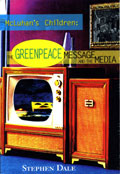
McLuhan's Children
The Greenpeace Message and the Media
Dale, Stephen
Publisher: Between the Lines, Toronto, Canada
Year Published: 1996
Pages: 220pp Price: $19.95 ISBN: 1-896357-04-0
Library of Congress Number: P96.E57D35 1996 Dewey: 363.7'0577
Resource Type: Book
Cx Number: CX8401
Looks at Greenpeace's rise to global prominence through its savvy use of mass media. Traces the evolution of Greenpeace's relations with the media.
Abstract:
Stephen Dales' McLuhan's Children is not a chronicle of Greenpeace's life as the world's best known environmental activist group. Rather, it is an examination of how that success has been due to an uncanny ability to exploit the realities of the modern media.
Greenpeace has achieved a unique symbiosis with the media, argues Dale, predicated on an understanding of the power of the visual image. Greenpeace has grown from a small group of idealists influenced by the spiritual traditions of First Nations peoples into a world-wide institution. This transformation did not take place without conflict.
"[T]he Save the Seals campaign brought into sharp relief two key but inherently contradictory aspects of Greenpeace's nature: the intense spiritual commitment of many of its members, and the organization's alliance with the mass media - that fickle, superficial, unforgiving appendage of the consumer society that we all know and sometimes hate."
That Greenpeace's message has been so successful is a tribute to the organization's intuitive understanding of Marshall McLuhan's theories about modern communication. Rather than relying on the logic chain thinking of written communication, Greenpeace makes its mark with powerful images in the modern medium of television. Baby seals being clubbed, brave eco-warriors standing up to whaling ships -- this instinctive understanding of the new visual currency has turned Greenpeace into an international force to be reckoned with.
Dale's book does an excellent job of revealing the complexities of both the issues involved in global environmental activism, and of the ethical quandaries posed to those who would make a difference in that field. Greenpeace has learned the hard way, argues Dale, of the dangerous oversimplifications spawned by the seductive, emotive, visual image. After the international boycott on seal pelts spelled devastation for many Native livelihoods, many in Greenpeace looked anew at the consequences of the uni-dimensional arguments put forward by sound-bite activism. How could the complexity of international environmental issues, linked in so many cases not by cuddly animals but by economic systems of domination and control, be expressed to a TV-viewing audience?
The image of today's Greenpeace which emerges from McLuhan's Children is of a two-sided organization. Greenpeace has struggled to integrate the lessons of three decades of both love-affair and betrayal in its alliance with modern media. On the one hand, it remains a media-savvy global organizer, fomenting public outrage through carefully controlled media placements, able to ride that tide of public opinion into the back rooms of international commissions and regulations councils. On the other hand is the unsung hero of both Greenpeace and the larger world of activism and grassroots organizing. The community-level co-operation and aid which Greenpeace provides are documented here by Dale, revealing an insight into a truth about the modern world. In order to make change, we operate in two worlds, the sleek, high-colour glow of television, where we passively absorb a simplified reality, and the daily, human interaction of community and connection, where we grapple with the contradictions and complexities of life.
-
Table of Contents
Acknowledgements
1. Introduction
2. From the Control Tower
3. Cultural Shifts and New Spaces: Global Strategies and Gridlock
4. Global Village or Divided Planet?
5. Behind the Mask: Conflict, Crisis, and Creativity Behind the Media Image
6. Civil Wars and Seal Hunts
7. The Quest for Coverage: In Technology We Trust
8. Mass Media and Mass Action: The Challenge of a New Environmentalism
9. Manufacturing Events; Swashbucklers, Scientists, and Dolphin-Tuna Turf Wars
10. The Big Trade-Off: From Media Circus to Diplomatic Arena
11. After the Cold War: Rethinking Strategies for a New Age
Notes
Index
Subject Headings


